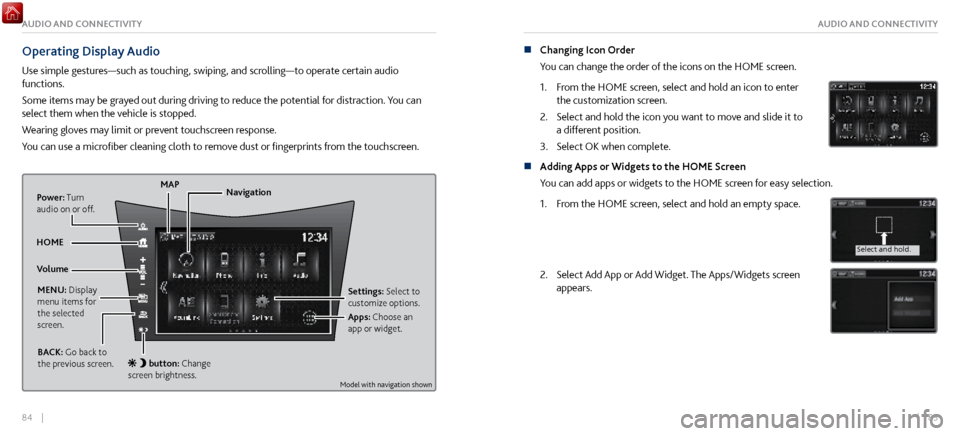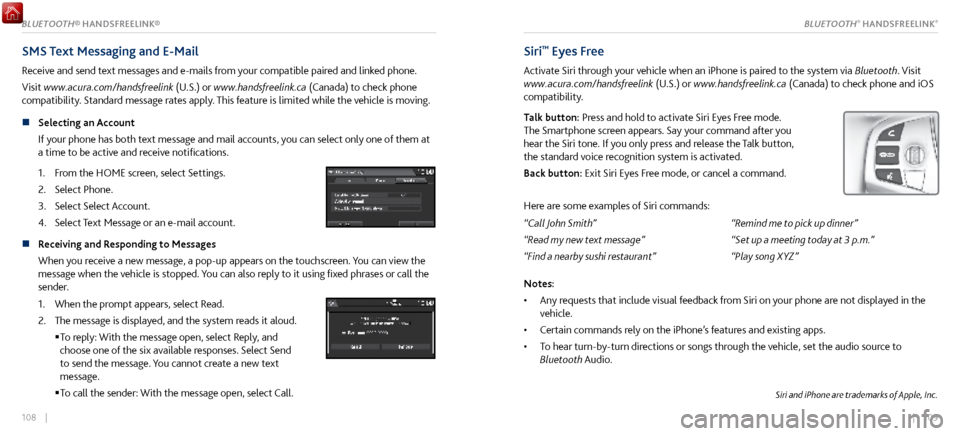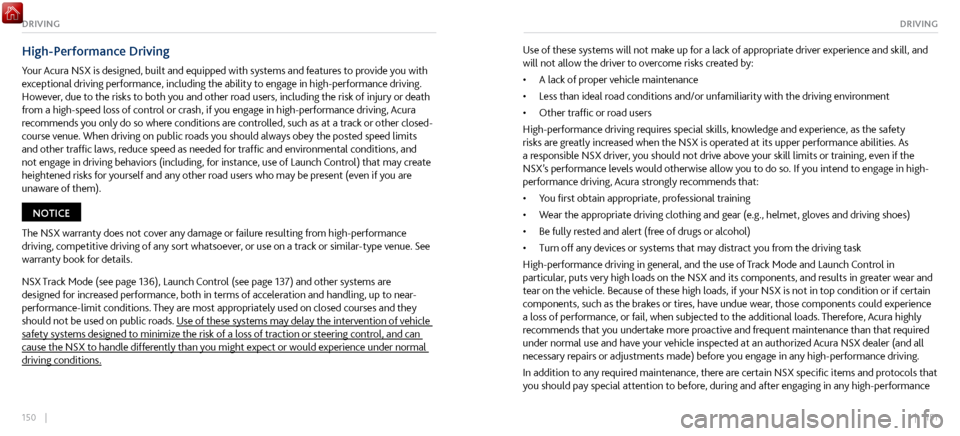2017 Acura NSX ESP
[x] Cancel search: ESPPage 10 of 116

14 || 15
SAFETYSAFETY
Your vehicle is not recommended for child passengers.
The National Highway Traffic Safety Administration and Transport Canada recommend that
all children ages 12 and under be properly restrained in a back seat. Since this vehicle does
not have a back seat, Acura recommends you do not carry as a passenger a child aged 12 or
under because:
•
An inflating front or side airbag can injur
e or kill a child sitting in the passenger’s seat.
•
A child in the passenger’s seat is mor
e likely to interfere with the driver’s ability to safely
control the vehicle.
•
Statistics show that children of all siz
es and ages are safer when they are properly
restrained in a rear seat.
•
Any child who is too small
to wear a seat belt correctly must be restrained in an approved
child seat that is properly secured to the vehicle using either the lap belt portion of the
lap/shoulder belt or the lower anchors of the LATCH system.
n
Safety Messages
When y
ou see the following messages throughout this guide, pay close attention.
DANGERYou WILL be KILLED or SERIOUSLY HURT if you don’t follow instructions.
WARNINGYou CAN be KILLED or SERIOUSLY HURT if you don’t follow instructions.
CAUTIONYou CAN be HURT if you don’t follow instructions.
NOTICE This information is intended to help you avoid damage to your vehicle,
other property, or the environment.
SAFETY INFORMATION
Your safety—and the safety of others—is very important, and operating this vehicle safely is an
important responsibility. While we strive to help you make informed decisions about safety,
it is not practical or possible to warn you about all the hazards associated with operating or
maintaining your vehicle. Therefore, you must use your own good judgment.
n
Important Safety Information
This guide explains many of
your vehicle’s safety features and how to use them. Please read
this information carefully. Following the instructions below will also help to keep you and
your passengers safe.
n
Important Safety Precautions
•
Always wear y
our seat belt.
•
Be aware of airbag hazards.
•
Don’t drink and drive.
•
Pay appropriate
attention to the task of driving safely.
•
Control your
speed.
•
Keep your
vehicle in safe condition.
Engaging in cell phone conversation or other activities that keep you from paying close
attention to the road, other vehicles, and pedestrians could lead to a crash. Remember,
situations can change quickly, and only you can decide when it is safe to divert some
attention away from driving.
Page 20 of 116

34 || 35
SAFETYSAFETY
• Never put a seat belt over yourself or a passenger and a child. During a crash, the belt would
likely pr
ess deep into the child and cause serious or fatal injuries.
•
Never let two children use
the same seat belt. Both children could be very seriously injured
in a crash.
•
Do not allow childr
en to operate the doors, windows, or seat adjustments.
•
Do not leave children in the
vehicle unattended, especially in hot weather when the inside
of the vehicle can get hot enough to kill them. They could also activate vehicle controls,
causing it to move unexpectedly.
Allowing a child to play with a seat belt or wrap one around their neck can result in
serious injury or death.
Instruct children not to play with any seat belt and make sure any unused seat belt a
child can reach is buckled, fully retracted, and locked.
WARNING
Children who are unrestrained or improperly restrained can be seriously injured or
killed in a crash.
Any child too small for a seat belt should be properly restrained in a child seat.
A larger child should be properly restrained with a seat belt, using a booster seat if
necessary.
WARNING
n Protecting Infants
An infant must be properly r
estrained in a rear-facing, reclining child seat until the infant
reaches the seat maker’s weight or height limit for the seat, and the infant is at least one
year old. Because rear-facing child seats should not be used in this vehicle, you should
never carry an infant in this vehicle.
Placing a rear-facing child seat in the front seat can result in serious injury or
death during a crash.
Never install a rear-facing child seat in this vehicle.
WARNING
Page 38 of 116

70 || 71
VEHICLE CONTROLSVEHICLE CONTROLS
n Adjusting the Steering Wheel
The steering wheel height and distance
from your body can be adjusted so that you can
comfortably grip the steering wheel in an appropriate driving posture.
1.
Pull up the steering wheel adjustment lever
.
2.
Move the steering
wheel up or down, and in or out.
3.
Push down the steering wheel adjustment lev
er to lock
the steering wheel in position.
To adjust
To lock
Lever
Adjusting the steering wheel position while driving may cause you to lose control
of the vehicle and be seriously injured in a crash.
Adjust the steering wheel only when the vehicle is stopped.
WARNING
Driving Position Memory System*
You can store two driver’s seat and door mirror positions into memory when the vehicle is
on. When you unlock and open the driver’s door with a remote transmitter, the seat and door
mirrors adjust automatically to the corresponding preset positions.
Adjust the seat and mirrors to your preferred positions.
1.
Press SET.
2.
Press and hold memory button 1 or 2. Y
ou will
hear two beeps when the memory is set.
Press one of the memory buttons to recall previously stored
positions. Lumbar positions cannot be stored.
SET Button
Memory
Button
1
Memory
Button 2
*if equipped
Page 45 of 116

84 || 85
AUDIO AND CONNECTIVITYAUDIO AND CONNECTIVITY
Operating Display Audio
Use simple gestures—such as touching, swiping, and scrolling—to operate certain audio
functions.
Some items may be grayed out during driving to reduce the potential for distraction. You can
select them when the vehicle is stopped.
Wearing gloves may limit or prevent touchscreen response.
You can use a microfiber cleaning cloth to remove dust or fingerprints from the touchscreen.
Power: Turn
audio on or off.
HOME MAP
MENU: Display
menu items for
the selected
screen. BACK: Go back to
the previous screen.
button: Change
screen brightness. Settings: Select to
customize options.
Navigation
Volume Apps: Choose an
app or widget.
n Changing Icon Order
You can change the order of the icons on the HOME screen.
1.
From the HOME scr
een, select and hold an icon to enter
the customization screen.
2.
Select and hold the icon you
want to move and slide it to
a different position.
3.
Select OK when complete.
n Adding Apps or Widgets to the HOME Screen
You can add apps or widgets to the HOME screen for easy selection.
1.
From the HOME scr
een, select and hold an empty space.
Select and hold.
Select and hold.
Drag and drop.
2. Select Add App or Add Widget. The Apps/Widgets screen
appears.
Select and hold.
Select and hold .
Drag and drop.
Model with navigation shown
Page 57 of 116

108 || 109
SMS Text Messaging and E-Mail
Receive and send text messages and e-mails from your compatible paired and linked phone.
Visit www.acura.com/handsfreelink (U.S.) or www.handsfreelink.ca (Canada) to check phone
compatibility. Standard message rates apply. This feature is limited while the vehicle is moving.
n
Selecting an Account
If y
our phone has both text message and mail accounts, you can select only one of them at
a time to be active and receive notifications.
1.
From the HOME scr
een, select Settings.
2.
Select Phone.
3.
Select Select Account.
4.
Select Text Message or an e-mail account
.
n Receiving and Responding to Messages
When you receive a new message, a pop-up appears on the touchscreen. You can view the
message when the vehicle is stopped. You can also reply to it using fixed phrases or call the
sender.
1.
When the prompt appears, select Read.
2.
The message is displayed, and the system r
eads it aloud.
To reply:
With the message open, select Reply, and
choose one of the six available responses. Select Send
to send the message. You cannot create a new text
message.
To call the sender: With
the message open, select Call.
Siri™ Eyes Free
Activate Siri through your vehicle when an iPhone is paired to the system via Bluetooth. Visit
www.acura.com/handsfreelink (U.S.) or www.handsfreelink.ca (Canada) to check phone and iOS
compatibility.
Talk button: Press and hold to activate Siri Eyes Free mode.
The Smartphone screen appears. Say your command after you
hear the Siri tone. If you only press and release the Talk button,
the standard voice recognition system is activated.
Back button: Exit Siri Eyes Free mode, or cancel a command.
Here are some examples of Siri commands:
“Call John Smith”
“Read my new text message”
“Find a nearby sushi restaurant” “Remind me to pick up dinner”
“Set up a meeting today at 3 p.m.”
“Play song XYZ”
Notes:
•
Any requests that include
visual feedback from Siri on your phone are not displayed in the
vehicle.
•
Certain commands rely
on the iPhone’s features and existing apps.
•
To hear turn-by-turn dir
ections or songs through the vehicle, set the audio source to
Bluetooth Audio.
Siri and iPhone are trademarks of Apple, Inc.
BLUETOOTH® HANDSFREELINK®BLUETOOTH® HANDSFREELINK®
Page 71 of 116

136 || 137
DRIVINGDRIVING
Integrated Dynamics System (IDS)
Choose a driving mode for your preference based on road conditions, vehicle speed, and
handling.
SPORT modeSPORT+ mode
Hold
QUIET mode
IDS Mode Switch
TRACK mode
QUIET: Prioritizes EV operation and quiet sound. Engine speed is limited to 4000 rpm.
SPORT: Balances sport and touring driving performance for enjoyable everyday driving.
SPORT+: Offers heightened dynamic response. EV operation is eliminated.
TRACK: Provides maximum, consistent performance from all dynamic systems. In Sport+ mode,
turn and hold the IDS switch to engage this mode. VSA activity is reduced and the VSA indicator
lamp illuminates. This mode is for closed-course use only. See also page 150. n
Launch Control
The v
ehicle controls the engine and transmission response for maximum acceleration from
a stop. Launch control functions in TRACK mode, with VSA turned on. See also page 150.
This feature should be used only in closed-course settings.
To engage launch control:
1.
In Sport+ mode, turn and hold the IDS Mode
Switch to
engage TRACK mode.
2. Depress the brake pedal and change the gear selector
to D/M. Keep the pedal depressed.
3. Release the parking brake.
Page 78 of 116

150 || 151
DRIVINGDRIVING
High-Performance Driving
Your Acura NSX is designed, built and equipped with systems and features to provide you with
exceptional driving performance, including the ability to engage in high-performance driving.
However, due to the risks to both you and other road users, including the risk of injury or death
from a high-speed loss of control or crash, if you engage in high-performance driving, Acura
recommends you only do so where conditions are controlled, such as at a track or other closed-
course venue. When driving on public roads you should always obey the posted speed limits
and other traffic laws, reduce speed as needed for traffic and environmental conditions, and
not engage in driving behaviors (including, for instance, use of Launch Control) that may create
heightened risks for yourself and any other road users who may be present (even if you are
unaware of them).
The NSX warranty does not cover any damage or failure resulting from high-performance
driving, competitive driving of any sort whatsoever, or use on a track or similar-type venue. See
warranty book for details.
NOTICE
NSX Track Mode (see page 136), Launch Control (see page 137) and other systems are
designed for increased performance, both in terms of acceleration and handling, up to near-
performance-limit conditions. They are most appropriately used on closed courses and they
should not be used on public roads. Use of these systems may delay the intervention of vehicle
safety systems designed to minimize the risk of a loss of traction or steering control, and can
cause the NSX to handle differently than you might expect or would experience under normal
driving conditions. Use of these systems will not make up for a lack of appropriate driver experience and skill, and
will not allow the driver to overcome risks created by:
•
A lack of proper v
ehicle maintenance
•
Less than ideal road conditions and/or unfamiliarity with
the driving environment
•
Other traffic or road users
High-performance
driving requires special skills, knowledge and experience, as the safety
risks are greatly increased when the NSX is operated at its upper performance abilities. As
a responsible NSX driver, you should not drive above your skill limits or training, even if the
NSX’s performance levels would otherwise allow you to do so. If you intend to engage in high-
performance driving, Acura strongly recommends that:
•
You first obtain appr
opriate, professional training
•
Wear the appropriate
driving clothing and gear (e.g., helmet, gloves and driving shoes)
•
Be fully rested and alert (fr
ee of drugs or alcohol)
•
Turn off any devices or systems that
may distract you from the driving task
High-performance driving in general, and the use of Track Mode and Launch Control in
particular, puts very high loads on the NSX and its components, and results in greater wear and
tear on the vehicle. Because of these high loads, if your NSX is not in top condition or if certain
components, such as the brakes or tires, have undue wear, those components could experience
a loss of performance, or fail, when subjected to the additional loads. Therefore, Acura highly
recommends that you undertake more proactive and frequent maintenance than that required
under normal use and have your vehicle inspected at an authorized Acura NSX dealer (and all
necessary repairs or adjustments made) before you engage in any high-performance driving.
In addition to any required maintenance, there are certain NSX specific items and protocols that
you should pay special attention to before, during and after engaging in any high-performance
Page 85 of 116

164 || 165
HANDLING THE UNEXPECTEDHANDLING THE UNEXPECTED
n Tire Pressure Monitoring System (TPMS) - Required Federal Explanation
Each tire, including
the spare (if provided), should be checked monthly when cold
and inflated to the inflation pressure recommended by the vehicle manufacturer
on the vehicle placard or tire inflation pressure label.
(If your vehicle has tires of a different size than the size indicated on the vehicle
placard or tire inflation pressure label, you should determine the proper tire
inflation pressure for those tires.)
As an added safety feature, your vehicle has been equipped with a tire
pressure monitoring system (TPMS) that illuminates a low tire pressure
telltale when one or more of your tires is significantly under-inflated.
Accordingly, when the low tire pressure telltale illuminates, you should stop and
check your tires as soon as possible, and inflate them to the proper pressure.
Driving on a significantly under-inflated tire causes the tire to overheat and can
lead to tire failure. Under-inflation also reduces fuel efficiency and tire tread life,
and may affect the vehicle’s handling and stopping ability.
Please note that the TPMS is not a substitute for proper tire maintenance, and it is
the driver’s responsibility to maintain correct tire pressure, even if under-inflation
has not reached the level to trigger illumination of the TPMS low tire pressure
telltale. Your vehicle has also been equipped with a TPMS malfunction indicator to indicate
when the system is not operating properly. The TPMS malfunction indicator
is combined with the low tire pressure telltale. When the system detects a
malfunction, the telltale will flash for approximately one minute and then remain
continuously illuminated. This sequence will continue upon subsequent vehicle
start-ups as long as the malfunction exists.
When the malfunction indicator is illuminated, the system may not be able to
detect or signal low tire pressure as intended.
TPMS malfunctions may occur for a variety of reasons, including the installation of
replacement or alternate tires or wheels on the vehicle that prevent the TPMS from
functioning properly.
Always check the TPMS malfunction telltale after replacing one or more tires
or wheels on your vehicle to ensure that the replacement or alternate tires and
wheels allow the TPMS to continue to function properly.